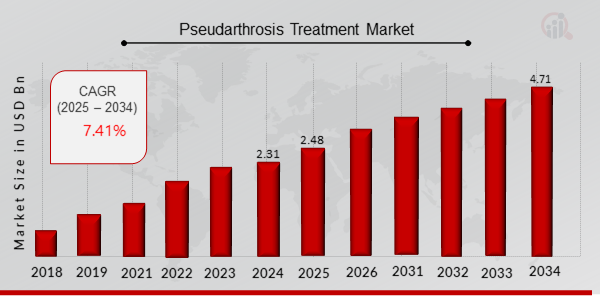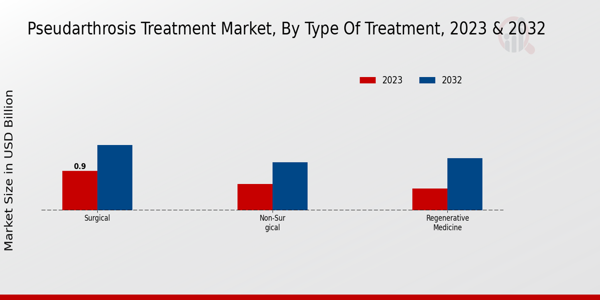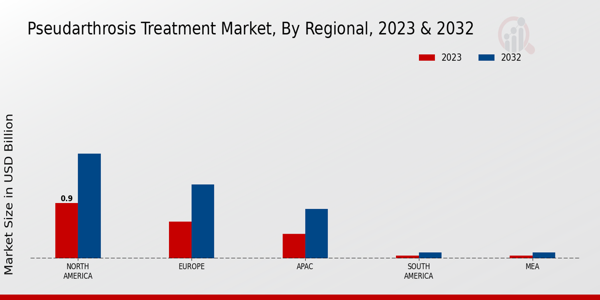Pseudarthrosis Treatment Market Overview
As per MRFR analysis, the Pseudarthrosis Treatment Market Size was estimated at 2.31 (USD Billion) in 2024. The Pseudarthrosis Treatment Market Industry is expected to grow from 2.48 (USD Billion) in 2025 to 4.71 (USD Billion) till 2034, at a CAGR (growth rate) is expected to be around 7.41% during the forecast period (2025 - 2034).
Key Pseudarthrosis Treatment Market Trends Highlighted
The Pseudarthrosis Treatment Market is witnessing significant drivers due to an increase in the incidence of fractures and bone-related disorders. The aging population, coupled with a rise in sedentary lifestyles and related health issues, has contributed to a growing demand for effective treatment solutions. Enhanced awareness of treatment options and advancements in medical technology are also propelling market growth as patients seek better outcomes and improved quality of life following non-union fractures.
Additionally, the push for more individualized treatment plans based on genetic and environmental factors is reshaping approaches in pseudarthrosis management. There are numerous opportunities to explore within this market, particularly with the development of novel therapies and innovative surgical techniques.
Biologics and regenerative medicine are gaining traction, offering the potential to improve healing rates and reduce complications associated with traditional surgical interventions. Market participants can also look into collaborative partnerships with research institutions to foster innovation and expand product portfolios. Furthermore, the increasing prevalence of sports-related injuries has created a niche for specialized treatments tailored to athletes, presenting a lucrative avenue for growth.
In recent times, the focus has shifted toward minimally invasive procedures and the integration of technology, like 3D printing and robotics, into surgery. Patients are increasingly looking for options that promise quicker recovery times and reduced hospital stays. There is also a noticeable trend in harnessing digital health solutions, enabling remote monitoring of patients post-surgery to ensure optimal recovery. The emphasis on holistic care, addressing both physical and psychological aspects of treatment, has also gained momentum as patients seek a comprehensive approach to their healing journey.

Source: Primary Research, Secondary Research, Market Research Future Database and Analyst Review
Pseudarthrosis Treatment Market Drivers
Increasing Incidence of Pseudarthrosis
The Pseudarthrosis Treatment Market Industry is experiencing significant growth driven by the increasing incidence of pseudarthrosis, a condition that arises when a broken bone fails to heal properly, leading to a non-union of the fracture. This can occur due to various factors, such as poor blood supply, infection, or improper surgical techniques.
As the global population continues to age, the prevalence of conditions that commonly lead to fractures, such as osteoporosis rises, resulting in a corresponding increase in cases of pseudarthrosis. Furthermore, lifestyle changes, including increased participation in high-impact sports among younger populations, could also lead to a higher rate of traumatic fractures, thereby affecting the market dynamics.
Advances in imaging techniques and diagnostic tools have enabled healthcare providers to better identify and treat pseudarthrosis, contributing to more effective management. The demand for better treatment solutions in the Pseudarthrosis Treatment Market Industry is also propelled by the need for improved surgical techniques, along with innovations in biological therapies and regenerative medicine.
As research in this field progresses, the availability of more effective treatment options will likely attract more patients, further elevating market growth.
Technological Advancements in Treatment Options
Technological advancements play a pivotal role in the expansion of the Pseudarthrosis Treatment Market Industry. Innovation in surgical techniques, implant materials, and biomaterials has improved the success rates of treatments. For example, new fixation devices and bone graft substitutes are being developed that enhance healing rates and decrease complications. These advancements also cater to a broader range of patients, thereby driving market growth.
Additionally, the integration of robotic-assisted surgical procedures offers new levels of precision in treatment, further improving recovery outcomes.
Rising Awareness and Education Among Healthcare Providers
There is a noticeable increase in awareness and education among healthcare providers regarding pseudarthrosis and its treatment options. This growth in knowledge is contributing to improved diagnosis and better treatment protocols in the Pseudarthrosis Treatment Market Industry. Medical professionals are becoming more aware of the latest developments in pseudarthrosis treatments, including cutting-edge surgical procedures and innovative drug therapies.
As the awareness increases, healthcare providers are becoming more efficient in tackling this multifaceted disease, hence providing timely management. This can result in better patient outcomes as well as a rise in the overall market demand.
Pseudarthrosis Treatment Market Segment Insights
Pseudarthrosis Treatment Market Type of Treatment Insights
The Pseudarthrosis Treatment Market is witnessing a notable evolution in its Type of Treatment segment, with various approaches being explored and implemented to address this complex condition. In 2023, the market is valued at 2.0 USD Billion, and the distribution of this value across treatment types reveals key insights into the industry's dynamics.
The Surgical treatment approach holds a majority position, accounting for 0.9 USD Billion in 2023, and is projected to increase to 1.5 USD Billion by 2032. This dominance can be attributed to the effectiveness and necessity of surgical intervention in many pseudarthrosis cases, where other treatment modalities may not yield optimal outcomes. Surgical interventions often encompass various techniques, including fixation methods and bone grafting, which significantly contribute to the growing demand within this segment.
Non-surgical treatments, valued at 0.6 USD Billion in 2023, are also gaining traction, with projections indicating an increase to 1.1 USD Billion by 2032. This growth can be linked to a rising preference for less invasive options that can effectively manage symptoms and support healing. Non-surgical methods, such as physical therapy, medications, and external fixation devices, are often considered first-line approaches before surgical options are explored, providing significant value to patients seeking recovery without the risks associated with surgical procedures.
Furthermore, Regenerative Medicine, valued at 0.5 USD Billion in 2023, signifies a rapidly emerging area of interest within the Pseudarthrosis Treatment Market. Expected to reach 1.2 USD Billion by 2032, Regenerative Medicine focuses on innovative therapies that enhance the body’s intrinsic healing processes. Techniques like stem cell therapy and tissue engineering are gaining importance as they offer potential solutions for patients with chronic pseudarthrosis. The growing investment in research and development, coupled with advancements in biotechnologies, is driving growth in this segment, reflecting a shift toward more holistic and effective treatment philosophies.
The market reflects a diverse landscape influenced by various factors, including advancements in medical technologies, the aging population, and increasing awareness of treatment options available for pseudarthrosis. Leveraging trends toward personalized medicine and minimally invasive techniques will likely shape future strategies for stakeholders in this industry. The strategic focus on developing minimally invasive procedures and novel regenerative treatments presents significant opportunities for growth, driving innovation in the Pseudarthrosis Treatment Market.
As these treatment types progress, they provide a comprehensive toolkit for clinicians addressing the complex challenges associated with pseudarthrosis. The distribution of revenues across these treatment approaches indicates a well-rounded market structure, offering healthcare providers multiple avenues to address patient needs effectively while simultaneously pushing the boundaries of treatment efficacy and patient outcomes.

Source: Primary Research, Secondary Research, Market Research Future Database and Analyst Review
Pseudarthrosis Treatment Market Cause of Pseudarthrosis Insights
Trauma has emerged as one of the primary drivers leading to pseudarthrosis, as injuries can disrupt the healing of bone fractures. Infections, which can complicate surgical interventions or other injuries, play a crucial role in delaying or preventing the healing process, making them a significant area of concern. Genetic disorders contribute to pre-existing conditions that result in bone healing complications, further influencing treatment approaches.
Meanwhile, tumors can affect bone integrity and complicate healing, emphasizing the need for specialized treatments. The Pseudarthrosis Treatment Market segmentation reveals that these causes not only highlight the diverse nature of treatment needs but also showcase the importance of tailored therapeutic options for patients, resulting in a comprehensive growth trajectory for the industry. As the market evolves, trends in advanced surgical techniques and improved biomaterials are expected to address the challenges presented by these causes, driving market growth and expanding opportunities for stakeholders.
Pseudarthrosis Treatment Market Treatment Techniques Insights
Treatment techniques, including Bone Grafting, Internal Fixation, External Fixation and Electrical Stimulation, play a vital role in addressing pseudarthrosis, as they cater to specific patient needs and conditions. Bone Grafting remains a popular choice due to its effectiveness in promoting healing by providing structural support and enhancing bone formation. Internal Fixation is pivotal for ensuring stability and alignment of fractured bones, particularly in complex cases, while External Fixation serves as a crucial alternative for stabilizing bone during the healing process, especially in compromised conditions.
Furthermore, Electrical Stimulation has emerged as an innovative approach, leveraging electrical impulses to accelerate healing and stimulate bone growth, particularly in cases where traditional methods may not suffice. The segmentation of the Pseudarthrosis Treatment Market reflects not only the diversity of treatment approaches but also the adaptability to patient-specific requirements, fostering growth and advancement in this vital industry. This dynamic market growth is driven by increasing incidences of trauma and orthopedic surgeries, alongside rising awareness and advancements in treatment methodologies.
Pseudarthrosis Treatment Market Patient Age Group Insights
In terms of Patient Age Group, the market is segmented into Pediatric, Adult and Geriatric populations, each contributing uniquely to the overall market dynamics. The Pediatric segment is significant due to the need for specialized treatment options that cater to the unique physiological characteristics of younger patients, as well as their growing population. Adults represent a considerable portion of the market, often facing injuries or conditions leading to pseudarthrosis, influenced by lifestyle factors and higher activity levels.
The Geriatric age group is increasingly dominating the market, as this demographic experiences higher incidences of bone-related disorders due to age-related degeneration. The confluence of these critical age groups highlights essential factors in the Pseudarthrosis Treatment Market data, impacting treatment availability, insurance coverage, and targeted therapies needed to meet the rising demand.
Market growth in this sector is, therefore, driven by an increasing incidence of pseudarthrosis, along with advancements in treatment technologies designed to address the specific needs of each age group, making it a focal point for healthcare providers and investors alike.
Pseudarthrosis Treatment Market Regional Insights
The Pseudarthrosis Treatment Market is poised for steady growth across various regions, showcasing significant revenue contributions. In 2023, North America leads with a valuation of 0.9 USD Billion, reflecting a majority holding in the market due to advanced healthcare infrastructure and high demand for specialized treatments. Europe follows, valued at 0.6 USD Billion, with its prominent research and development initiatives driving innovations in treatment options. The Asia-Pacific (APAC) region, valued at 0.4 USD Billion in 2023, is gaining momentum as rising patient awareness and improving healthcare systems enhance market access.
Meanwhile, South America and the Middle East Africa (MEA), both valued at 0.05 USD Billion, represent the emerging markets in this sector, with potential growth opportunities stemming from increased healthcare investments. The diversity in these market valuations illustrates the varying needs and capabilities across regions, shaping the landscape of the Pseudarthrosis Treatment Market. As the market continues to evolve, growth drivers include advancements in treatment modalities and increased prevalence of pseudarthrosis conditions, while challenges may arise from the differential access to healthcare services in less dominant markets.

Source: Primary Research, Secondary Research, Market Research Future Database and Analyst Review
Pseudarthrosis Treatment Market Key Players and Competitive Insights
The Pseudarthrosis Treatment Market is characterized by a diverse array of treatment options, including surgical and non-surgical interventions that address the complex nature of pseudarthrosis. This market landscape is influenced by numerous factors, such as the prevalence of musculoskeletal disorders, technological advancement in treatment methodologies, and rising demand for innovative therapeutic solutions. The competitive landscape is further intensified by various market players who are vying for a significant share through strategic partnerships, research and development investments, and the continual introduction of new products aimed at improving patient outcomes.
The interactions between market participants also play a vital role in shaping strategies and advancements, leading to a dynamic environment that fosters growth and innovation. Orthofix has established a strong foothold in the Pseudarthrosis Treatment Market by leveraging its advanced biotechnological solutions and comprehensive product offerings. Known for its patient-centric approach, Orthofix emphasizes innovation and effectiveness in its treatment devices, aiming to reduce recovery times for patients suffering from pseudarthrosis.
The company's commitment to quality and safety enhances its market presence, offering a range of therapeutic solutions that are not only effective but also align with the latest clinical guidelines. Orthofix's ability to integrate cutting-edge technology with reliable orthopedic solutions allows it to serve a broad spectrum of medical professionals and institutions while fostering beneficial relationships within the healthcare community, thus solidifying its reputation in the pseudarthrosis treatment space. Acelity is recognized for its innovative wound care and regenerative medicine products within the Pseudarthrosis Treatment Market.
The company focuses on developing advanced therapeutic solutions that promote healing and potentially enhance the recovery process for individuals suffering from pseudarthrosis. Acelity's emphasis on industry-leading research and a strong portfolio of proprietary technologies clearly underscores its strengths in dealing with complex orthopedic conditions. With a well-defined strategy that integrates scientific research with practical healthcare applications, Acelity continues to advance treatment protocols and options. The company's dedication to improving patient outcomes not only enhances its competitive positioning but also establishes Acelity as a respected leader that healthcare providers often look to when addressing the challenges associated with pseudarthrosis.
Key Companies in the Pseudarthrosis Treatment Market Include
Pseudarthrosis Treatment Market Industry Developments
In recent developments within the Pseudarthrosis Treatment Market, several companies are making notable strides. Orthofix has been advancing its product portfolio, particularly focusing on its bone growth stimulation technologies. Acelity continues to drive innovation in regenerative medicine, emphasizing wound-healing solutions that may benefit pseudarthrosis cases.
Additionally, Stryker and Tornier are exploring synergies in their orthopedic offerings to enhance surgical outcomes. Mergers and acquisitions have also taken center stage, with Zimmer Biomet recently acquiring a strategic interest in a startup focused on novel bone healing technologies, further solidifying its market position. The market is witnessing a surge in valuations for companies like NuVasive and Medtronic, which are scaling up efforts in minimally invasive spinal surgery. Companies such as Smith Nephew and DePuy Synthes are focusing on enhancing mechanical stability in grafts and implants to combat pseudarthrosis effectively.
Bioventus and Globus Medical are expanding their presence in therapies aimed at optimizing bone healing, driven by increasing demand for advanced treatment modalities. This dynamic environment highlights the critical innovations and business maneuvers shaping the landscape of the pseudarthrosis treatment market.
Pseudarthrosis Treatment Market Segmentation Insights
Pseudarthrosis Treatment Market Type of Treatment Outlook
Pseudarthrosis Treatment Market Cause of Pseudarthrosis Outlook
Pseudarthrosis Treatment Market Treatment Techniques Outlook
Pseudarthrosis Treatment Market Patient Age Group Outlook
Pseudarthrosis Treatment Market Regional Outlook
| Report Attribute/Metric |
Details |
|
Market Size 2024
|
2.31 (USD Billion)
|
|
Market Size 2025
|
2.48 (USD Billion)
|
|
Market Size 2034
|
4.71 (USD Billion)
|
|
Compound Annual Growth Rate (CAGR)
|
7.41 % (2025 - 2034)
|
|
Report Coverage
|
Revenue Forecast, Competitive Landscape, Growth Factors, and Trends
|
|
Base Year
|
2024
|
|
Market Forecast Period
|
2025 - 2034
|
|
Historical Data
|
2020 - 2024
|
| Market Forecast Units |
USD Billion |
| Key Companies Profiled |
Orthofix, Acelity, Stryker, Tornier, Amedica, MediEvil, Smith and Nephew, DePuy Synthes, NuVasive, Bioventus, Globus Medical, Zimmer Biomet, Medtronic, Cerapedics, Integra LifeSciences |
| Segments Covered |
Type of Treatment, Cause of Pseudarthrosis, Treatment Techniques, Patient Age Group, Regional |
| Key Market Opportunities |
1. Advancements in surgical techniques, 2. Increasing demand for biologics, 3. Rising prevalence of spinal disorders, 4. Growth in orthopedic implants, 5. Enhancements in regenerative medicine |
| Key Market Dynamics |
1. Rising prevalence of pseudarthrosis, Increasing demand for advanced therapies, 2. Growth in orthopedic surgeries, 3. Innovations in treatment technologies, 4. Enhanced patient awareness and education |
| Countries Covered |
North America, Europe, APAC, South America, MEA |
Frequently Asked Questions (FAQ):
The Pseudarthrosis Treatment Market is expected to be valued at 2.0 USD Billion in 2023.
By 2034, the Pseudarthrosis Treatment Market is projected to reach a value of 3.8 USD Billion.
The Pseudarthrosis Treatment Market is expected to grow at a CAGR of 7.41% from 2025 to 2034.
In 2023, North America holds the largest market share, valued at 0.9 USD Billion.
The Pseudarthrosis Treatment Market in Europe is valued at 0.6 USD Billion in 2023.
The Non-Surgical treatment segment is expected to be valued at 1.1 USD Billion by 2034.
The Surgical treatment segment is valued at 0.9 USD Billion in 2023.
Key players in the market include Orthofix, Stryker, and DePuy Synthes among others.
The APAC region is expected to grow to 0.8 USD Billion by 2034.
The Regenerative Medicine treatment segment is projected to reach a value of 1.2 USD Billion by 2034.

















